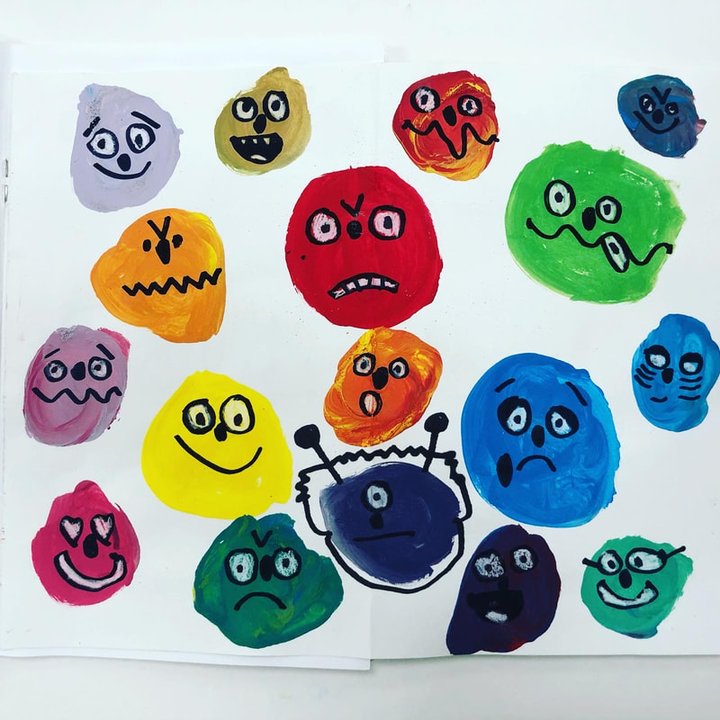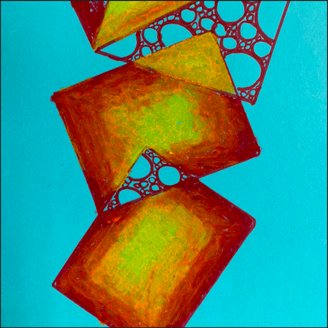
A kindergarten student’s “Mixed” artwork | Image from artsintegration.net
###
If we could forget that education ever existed, and start over from scratch, what would it look like?
That’s a question — originally posed by Harvard Graduate School of Education’s Project Zero — that Bill Funkhouser, an arts education specialist for the Humboldt County Office of Education, keeps in mind.
“To me, that’s kind of what creative education is about. It’s about saying, ‘Let’s forget about all this baggage that we have in education, and really think about what works. What makes for a collaborative, creative classroom community?’” Funkhouser told the Outpost.
HCOE recently learned it is the recipient of a federal $3.3 million grant that will fund a program aiming to bring social-emotional learning through the arts to three local schools. The scope and goals of the project — which will be called ArtSEL (Art/Social-Emotional Learning) — remind Funkhouser, who is coordinating the program, of that question: What would a clean slate for education look like?
For one, he thinks it would involve a healthy, consistent scoop of social-emotional learning practices, incorporated into every aspect of any student’s day at school. Social-emotional learning involves guiding students toward developing person skills — stuff that isn’t necessarily in the syllabus, like self-awareness, self-management, social awareness, relationship skills and decision-making. Social-emotional learning isn’t a new educational concept, but its application has ballooned in recent years as more and more young people are facing mental health issues.
“We get so focused on the test scores and that sort of thing. And we go, ‘Why aren’t they succeeding?’” Funkhouser said. “And I think often the answer is, well, what are we doing to meet their social-emotional needs?”
Some teachers brush off that responsibility, Funkhouser said, figuring it’s up to parents to teach their children those skills at home.
“I just see that as a real opportunity missed, because at home they don’t have 30 other people from different backgrounds,” he said. “What a great opportunity for being given a chance to communicate, collaborate, work creatively in a classroom community, right? And that’s what we’re after. That’s what we’re trying to establish here.”
ArtSEL will span five years and will benefit three to-be-determined local K-8 schools. Every staff member at participating schools, from teachers to bus drivers to administrators, will undergo training pertaining to social-emotional learning, which, over the first year and with ongoing support over the following four, will accumulate in hundreds of hours of training.
“We want everybody who might be involved with that child’s life to have been trained in what it means to understand social-emotional learning [and] to understand what creativity looks like,” Funkhouser said. “We think that anybody who interacts with children in these schools has the potential to make a difference.”
HCOE Arts Program Manager and ArtSEL Director Stacy Young said that there is rarely the funding to train staff in such a wide scope. “Every adult that’s in a student’s life has the opportunity to grow from this grant,” Young told the Outpost. “It makes it really consistent for the students.”
Still deep in the pandemic, meeting children’s social and emotional needs is important as ever, Young said, pointing out that this year’s third-graders haven’t experienced a normal school year since kindergarten. “You’re looking at these social structures and norms that have been disrupted. I would argue that this grant would be helpful in any school in the United States,” Young said.
On top of that are Humboldt’s high rates of children in foster care and children experiencing homelessness, making the implementation of social-emotional learning even more essential, Funkhouser said.
In many cases, art is the perfect vessel for teaching social-emotional skills.
“We believe that children learn and thrive when their social-emotional needs are met. And we think the arts are a natural way to meet those needs,” Funkhouser said. The staff training will involve how to implement social-emotional learning across the core curriculum, which can often be achieved through the arts.

Third-grade students’ collaborative artwork | Image from artsintegration.net
For instance, a collaborative art project can introduce young kids to a host of social-emotional skills.
“They have to learn how to communicate what they think the artwork should look like, they have to learn how to compromise,” Funkhouser said. “And then [the students] make this artwork and none of [them] own it.”
Funkhouser referenced a specific lesson that he and (out of area) teacher Jonathan Juravich collaborated to develop. Based on the children’s book “Mixed” by Arree Chung — which is about a world where primary colors discover mixing after living separated from one another — the lesson, on the surface, is simply about mixing paint colors.
“It’s easier to talk about it in terms of a book, because there’s that distance of ‘Oh, we’re just talking about red and yellow, we’re not talking about racism, we’re not talking about xenophobia, we’re not talking about the hard topics yet.’ But we’re getting there,” Funkhouser said. “I think it’s an example of how SEL and the arts work really well together.”
Both Funkhouser and Young agree that the arts are not valued enough in today’s classrooms. Too often, the arts are reserved for after other learning — like math, science and language — is done, Funkhouser said, even though art can be integrated into all subjects and strengthen them, and even though the benefits of the arts are wide, like the social-emotional learning that can accompany them.
“This is an academic grant, where higher-order thinking is at the top of our goals, yet it is through the arts,” Funkhouser said.
Funkhouser and Young are excited and confident about the project, which is already off to a promising start. Of 109 applicants to the United States Department of Education, HCOE was one of 27 proposals that was awarded a grant, and the application scored 298 of 300 possible points.
ArtSEL is the second federally-funded program HCOE’s Arts Program has received and the fourth grant-funded program Funkhouser has coordinated. The resources used and developed over the course of those programs are all available on artsintegration.net, which has accumulated hundreds of pages and is visited by tens of thousands of users each year. Funkhouser is launching a new website — artsel.org — where all the resources developed for ArtSEL will be posted.
“[We’re] changing education in our community for the children and future citizens of our area,” Funkhouser said. “I think we’re making a difference.”
CLICK TO MANAGE